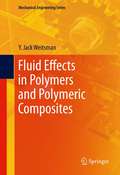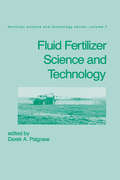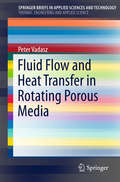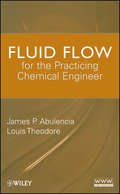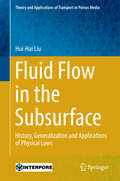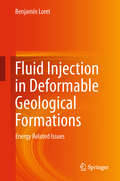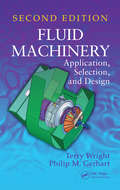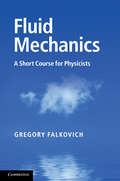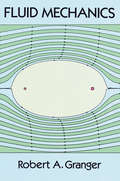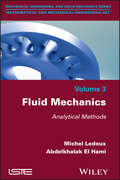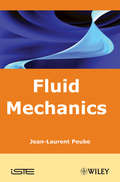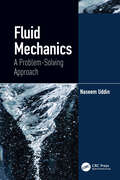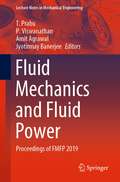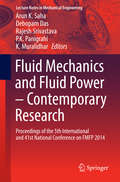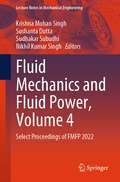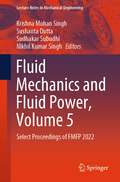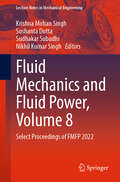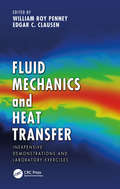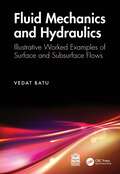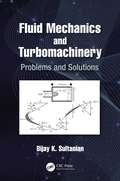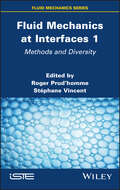- Table View
- List View
The Fluid Earth: Physical Science and Technology of the Marine Environment (3rd edition)
by E. Barbara Klemm Francis M. Pottenger III Thomas W. Speitel S. Arthur Reed Ann E. CoopersmithThis book offers students the opportunity to learn the basic concepts of science by investigating the oceans. They explore the physics, chemistry, and geology of the oceans and learn of their practical applications in ocean engineering.
Fluid Effects in Polymers and Polymeric Composites
by Y. Jack WeitsmanFluid Effects in Polymers and Polymeric Composites, written by the late Dr. Y. Jack Weitsman, addresses the wide range of parameters that affect the interaction of fluids with polymers and polymeric composites. The book aims at broadening the scope of available data, mostly limited up to this time to weight-gain recordings of fluid ingress into polymers and composites, to the practical circumstances of fluctuating exposure. Various forms of experimental data are given, in conjunction with theoretical models derived from basic scientific principles, and correlated with severity of exposure conditions and interpreted by means of rationally based theoretical models. The practical implications of the effects of fluids are discussed. The issue of fluid effects on polymers and polymeric composites is of concern to engineers and scientists active in aerospace and naval structures, as an increasing portion of these structures are made of polymeric composites and employ polymeric adhesives as a joining device. While the book is intended for this audience, it will also interest researchers and graduate students interested in the mechanics and materials aspects of this matter.
The Fluid Envelope of our Planet
by Eric L. MillsOceans have had a mysterious allure for centuries, inspiring fears, myths, and poetic imaginations. By the early twentieth century, however, scientists began to see oceans as physical phenomena that could be understood through mathematical geophysics. The Fluid Envelope of Our Planet explores the scientific developments from the early middle ages to the twentieth century that illuminated the once murky depths of oceanography.Tracing the transition from descriptive to mathematical analyses of the oceans, Eric Mills examines sailors' and explorers' observations of the oceans, the influence of Scandinavian techniques on German-speaking geographers, and the eventual development of shared quantitative practices and ideas. A detailed and beautifully written account of the history of oceanography, The Fluid Envelope of Our Planet is also an engaging account of the emergence of a scientific discipline.
Fluid Fertilizer Science and Technology: Proceedings No 514
by Derek A. PalgraveIllustrates current fluid fertilizer technology in the US and abroad, including manufacture, handling, storage, distribution, and use in the field demonstrating how fluid fertilizer facilitates more precise delivery of nutrition to crops. The volume provides the means to analyze fluid fertilizer sys
Fluid Flow and Heat Transfer in Porous Media Manufactured by a Space Holder Method (Springer Theses)
by Xianke LuThis book focuses on the effects of the material, porosity, pore size and pore shape on flow behaviour and heat transfer in microscale porous media manufactured using a space holder method. It also describes a novel approach to studying flow behaviour in non-transparent materials such as porous metals via flow visualization in transparent media that mimic the porous structure. The book employs a combination of microparticle image velocimetry – a modern, advanced technique – and pressure drop measurement – a more traditional method – that makes the mechanistic study of several phenomena possible. It covers the identification of various flow regimes and their boundaries, velocity profiles on the microscale, the heat transfer coefficient under forced convection, and the correlation between flow behaviour on the pore scale and the convective heat transfer performance of the porous media. Understanding the fundamentals of porous flow, especially on the microscale, is critical for applications of porous media in heat exchangers, catalytic convertors, chemical reactors, filtration and oil extraction. Accordingly, this book offers a valuable resource for all researchers, graduate students and engineers working in the areas of porous flow and porous materials.
Fluid Flow and Heat Transfer in Rotating Porous Media
by Peter VadaszThis Book concentrates the available knowledge on rotating fluid flow and heat transfer in porous media in one single reference. Dr. Vadasz develops the fundamental theory of rotating flow and heat transfer in porous media and introduces systematic classification and identification of the relevant problems. An initial distinction between rotating flows in isothermal heterogeneous porous systems and natural convection in homogeneous non-isothermal porous systems provides the two major classes of problems to be considered. A few examples of solutions to selected problems are presented, highlighting the significant impact of rotation on the flow in porous media.
Fluid Flow for the Practicing Chemical Engineer
by James P. Abulencia Louis TheodoreThis book teaches the fundamentals of fluid flow by including both theory and the applications of fluid flow in chemical engineering. It puts fluid flow in the context of other transport phenomena such as mass transfer and heat transfer, while covering the basics, from elementary flow mechanics to the law of conservation. The book then examines the applications of fluid flow, from laminar flow to filtration and ventilization. It closes with a discussion of special topics related to fluid flow, including environmental concerns and the economic reality of fluid flow applications.
Fluid Flow in the Subsurface
by Hui-Hai LiuThis book presents a systematic attempt to generalize several fundamental physical laws related to subsurface fluid flow that are important for a number of contemporary applications in the areas of hydrogeology, reservoir engineering and rock mechanics. It also covers the history of discovering these physical laws, their respective scope of validity, and their generalizations or extensions. The physical laws discussed include Darcy s law, Darcy-Buckingham law and Hooke s law. Darcy s law is the fundamental law for subsurface fluid flow. For low-permeability media, it is not always adequate because of the strong fluid solid interaction. Though the Darcy-Buckingham law is often used for modeling subsurface multiphase flow, it is only valid under the local equilibrium condition. This condition does not hold in many cases, especially when fingering flow occurs. It is well known that subsurface fluid flow is coupled with mechanical deformation of subsurface media; in some applications, this coupling can play a dominant role. The continuum-scale elastic deformation of natural rock, however, does not always follow the traditional form of Hooke s law. The book also presents applications of the proposed generalizations of the physical laws to several important engineering projects. "
Fluid Injection in Deformable Geological Formations: Energy Related Issues
by Benjamin LoretThis book offers an introduction to the geomechanical issues raised by both the extraction of actual and potential energy resources, and by the treatment of the ensuing environmental concerns. Discussions of the operations of injection of fluids into, and withdrawal from, geological formations link the chapters, each devoted to a particular technical aspect or scientific issue, or to a particular energy resource.Subjects are ordered according to their industrial applications, including enhanced oil and gas recovery, gas hydrates, enhanced geothermal systems, hydraulic fracturing, and carbon dioxide sequestration. An overview of the industrial, research and simulation aspects for each subject is provided. Fluid Injection in Deformable Geological Formations will be of interest to academic and industrial researchers in a wide variety of fields, including computational mechanics, civil engineering, geotechnical engineering and geomechanics, engineering seismology, petroleum engineering, reservoir engineering, and engineering geology.
Fluid Machinery: Application, Selection, and Design, Second Edition
by Terry Wright Philip GerhartPublished nearly a decade ago, Fluid Machinery: Performance, Analysis, and Design quickly became popular with students, professors, and professionals because of its comprehensive and comprehensible introduction to the fluid mechanics of turbomachinery. Renamed to reflect its wider scope and reorganized content, this second edition provides a more l
Fluid Mechanics: A Short Course For Physicists
by Gregory FalkovichThe multidisciplinary field of fluid mechanics is one of the most actively developing fields of physics, mathematics and engineering. <P><P>In this book, the fundamental ideas of fluid mechanics are presented from a physics perspective. Using examples taken from everyday life, from hydraulic jumps in a kitchen sink to Kelvin–Helmholtz instabilities in clouds, the book provides readers with a better understanding of the world around them. It teaches the art of fluid-mechanical estimates and shows how the ideas and methods developed to study the mechanics of fluids are used to analyze other systems with many degrees of freedom in statistical physics and field theory.<P> Aimed at undergraduate and graduate students, the book assumes no prior knowledge of the subject and only a basic understanding of vector calculus and analysis. It contains 32 exercises of varying difficulties, from simple estimates to elaborate calculations, with detailed solutions to help readers understand fluid mechanics.<P> Presents a unique perspective on fluid mechanics stressing its links with other branches of physics.<P> Examples and exercises are taken from everyday life, from the kitchen sink to sailing and flying, to give readers a better appreciation of the subject.<P> Teaches the art of physical estimates as applied to fluid mechanics.<P>
Fluid Mechanics: A Short Course for Physicists
by Gregory FalkovichThe multidisciplinary field of fluid mechanics is one of the most actively developing fields of physics, mathematics and engineering. In this book, the fundamental ideas of fluid mechanics are presented from a physics perspective. Using examples taken from everyday life, from hydraulic jumps in a kitchen sink to Kelvin-Helmholtz instabilities in clouds, the book provides readers with a better understanding of the world around them. It teaches the art of fluid-mechanical estimates and shows how the ideas and methods developed to study the mechanics of fluids are used to analyze other systems with many degrees of freedom in statistical physics and field theory. Aimed at undergraduate and graduate students, the book assumes no prior knowledge of the subject and only a basic understanding of vector calculus and analysis. It contains 32 exercises of varying difficulties, from simple estimates to elaborate calculations, with detailed solutions to help readers understand fluid mechanics.
Fluid Mechanics (Dover Books on Physics)
by Robert A. Granger"The mixture of prose, mathematics, and beautiful illustrations is particularly well chosen." -- American ScientistThis monumental text by a noted authority in the field is specially designed to provide an orderly structured introduction to fluid mechanics, a field all too often seen by students as an amorphous mass of disparate equations instead of the coherent body of theory and application it should be. In addition, the book will help upgrade students' mathematical skills as they learn the fundamentals of fluid mechanics.The text presents a unified method of analysis that poses fluid mechanics problems in precise mathematical language without becoming stiff or unnecessarily rigorous. This method involves three steps: First, the text carefully defines each problem so the student knows what is given and what is missing. Second, each chapter treats the physical aspects of the problems so the student can visualize how things work in the real world. Third, the text represents the physical model by appropriate mathematical symbols and operators, collects these into equations, and then solves them. The result is a superb learning and teaching process that covers everything the engineer needs to know -- nature of fluids, hydrostatics, differential and integral equations, dimensional analysis, viscous flows, and other topics -- while allowing students to see each element in its relation to the whole.Each chapter contains numerous examples incorporating problem-solving techniques, demonstrations to illustrate topical material, study questions, boxed equations of significant results, appropriate references to supplementary materials and other study aids. Over 760 illustrations enhance the text. This volume will be an indispensable reference and resource for any student of fluid mechanics or practicing engineer.
Fluid Mechanics: Analytical Methods
by Abdelkhalak El Hami Michel LedouxThe book aims to provide an efficient methodology of solving a fluid mechanics problem. It aims to meet different objectives of the student, the future engineer or scientist. Using simple sizing calculations, and more advanced analytical calculations, the book covers all the essential numerical approaches for solving complex practical problems.
Fluid Mechanics
by Jean-Laurent PuebeThis book examines the phenomena of fluid flow and transfer as governed by mechanics and thermodynamics. Part 1 concentrates on equations coming from balance laws and also discusses transportation phenomena and propagation of shock waves. Part 2 explains the basic methods of metrology, signal processing, and system modeling, using a selection of examples of fluid and thermal mechanics.
Fluid Mechanics: A Problem-Solving Approach
by Naseem UddinFluid Mechanics: A Problem-Solving Approach provides a clear distinction between integral formulation and the different formulation of conservation law. Including a detailed discussion on pipe flow correlations, entrance length correlations, and plotting of Moody diagram, the book works through the comprehensive coverage of fluid mechanics with a gradual introduction of theory in a straightforward, practical approach. The book includes numerous end-of-chapter problems to enhance student understanding and different solving approaches. It features chapters on nanofluids, jets, waves in ocean and rivers, boundary layer separation, and Thwaites integral method, which are not typically covered in an introductory course. Features Provides a comprehensive treatment of fluid mechanics from the basic concepts to in-depth application problems. Covers waves and tsunamis. Offers two distinct chapters on jet flows and turbulent flows. Includes numerous end-of-chapter problems. Includes a Solutions Manual and MAPLE worksheets for instructor use. The book is intended for senior undergraduate mechanical and civil engineering students taking courses in fluid mechanics. The eBook+ version includes the following enhancements: 3 videos placed throughout the text to help apply real-world examples to concepts of Newtonian vs. Non-Newtonian fluids, vortices, and additional information on surface tension. Pop-up explanations of selected concepts as interactive flashcards in each chapter. Quizzes within chapters to help readers refresh their knowledge.
Fluid Mechanics and Fluid Power: Proceedings of FMFP 2019 (Lecture Notes in Mechanical Engineering)
by T. Prabu P. Viswanathan Amit Agrawal Jyotirmay BanerjeeThis book comprises select proceedings of the 46th National Conference on Fluid Mechanics and Fluid Power (FMFP 2019). The contents of this book focus on aerodynamics and flow control, computational fluid dynamics, fluid structure interaction, noise and aero-acoustics, unsteady and pulsating flows, vortex dynamics, nuclear thermal hydraulics, heat transfer in nanofluids, etc. This book serves as a useful reference beneficial to researchers, academicians and students interested in the broad field of mechanics.^
Fluid Mechanics and Fluid Power – Contemporary Research
by Arun K. Saha Debopam Das Rajesh Srivastava P. K. Panigrahi K. MuralidharThis volume comprises the proceedings of the 42nd National and 5th International Conference on Fluid Mechanics and Fluid Power held at IIT Kanpur in December, 2014. The conference proceedings encapsulate the best deliberations held during the conference. The diversity of participation in the conference, from academia, industry and research laboratories reflects in the articles appearing in the volume. This contributed volume has articles from authors who have participated in the conference on thematic areas such as Fundamental Issues and Perspectives in Fluid Mechanics; Measurement Techniques and Instrumentation; Computational Fluid Dynamics; Instability, Transition and Turbulence; Turbomachinery; Multiphase Flows; Fluid‐Structure Interaction and Flow‐Induced Noise; Microfluidics; Bio‐inspired Fluid Mechanics; Internal Combustion Engines and Gas Turbines; and Specialized Topics. The contents of this volume will prove useful to researchers from industry and academia alike.
Fluid Mechanics and Fluid Power, Volume 4: Select Proceedings of FMFP 2022 (Lecture Notes in Mechanical Engineering)
by Krishna Mohan Singh Sushanta Dutta Sudhakar Subudhi Nikhil Kumar SinghThis book comprises select peer-reviewed proceedings of the 9th International and 49th National Conference on Fluid Mechanics and Fluid Power (FMFP 2022). This book brings together scientific ideas and engineering solutions put forth by researchers and practitioners from academia and industry in the important and ubiquitous field of fluid mechanics. The contents of this book focus on fundamental issues and perspective in fluid mechanics, measurement techniques in fluid mechanics, computational fluid and gas dynamics, instability, transition and turbulence, fluid-structure interaction, multiphase flows, microfluidics, bio-inspired fluid mechanics, aerodynamics, turbomachinery, propulsion and power and other miscellaneous topics in the broad domain of fluid mechanics. This book is a useful reference to researchers and professionals working in the broad field of mechanics.
Fluid Mechanics and Fluid Power, Volume 5: Select Proceedings of FMFP 2022 (Lecture Notes in Mechanical Engineering)
by Krishna Mohan Singh Sushanta Dutta Sudhakar Subudhi Nikhil Kumar SinghThis book comprises select peer-reviewed proceedings of the 9th International and 49th National Conference on Fluid Mechanics and Fluid Power (FMFP 2022). This book brings together scientific ideas and engineering solutions put forth by researchers and practitioners from academia and industry in the important and ubiquitous field of fluid mechanics. The contents of this book focus on fundamental issues and perspective in fluid mechanics, measurement techniques in fluid mechanics, computational fluid and gas dynamics, instability, transition and turbulence, fluid-structure interaction, multiphase flows, microfluidics, bio-inspired fluid mechanics, aerodynamics, turbomachinery, propulsion and power and other miscellaneous topics in the broad domain of fluid mechanics. This book is a useful reference to researchers and professionals working in the broad field of mechanics.
Fluid Mechanics and Fluid Power, Volume 8: Select Proceedings of FMFP 2022 (Lecture Notes in Mechanical Engineering)
by Sudhakar Subudhi Krishna Mohan Singh Sushanta Dutta Nikhil Kumar SinghThis book comprises select peer-reviewed proceedings of the 9th International and 49th National Conference on Fluid Mechanics and Fluid Power (FMFP 2022). This book brings together scientific ideas and engineering solutions put forth by researchers and practitioners from academia and industry in the important and ubiquitous field of fluid mechanics. The contents of this book focus on fundamental issues and perspective in fluid mechanics, measurement techniques in fluid mechanics, computational fluid and gas dynamics, instability, transition and turbulence, fluid-structure interaction, multiphase flows, microfluidics, bio-inspired fluid mechanics, aerodynamics, turbomachinery, propulsion and power and other miscellaneous topics in the broad domain of fluid mechanics. This book is a useful reference to researchers and professionals working in the broad field of mechanics.
Fluid Mechanics and Heat Transfer: Inexpensive Demonstrations and Laboratory Exercises
by William Roy Penney and Edgar C. ClausenThis practical book provides instruction on how to conduct several "hands-on" experiments for laboratory demonstration in the teaching of heat transfer and fluid dynamics. It is an ideal resource for chemical engineering, mechanical engineering, and engineering technology professors and instructors starting a new laboratory or in need of cost-effective and easy to replicate demonstrations. The book details the equipment required to perform each experiment (much of which is made up of materials readily available is most laboratories), along with the required experimental protocol and safety precautions. Background theory is presented for each experiment, as well as sample data collected by students, and a complete analysis and treatment of the data using correlations from the literature.
Fluid Mechanics and Hydraulics: Illustrative Worked Examples of Surface and Subsurface Flows
by Vedat BatuFluid Mechanics and Hydraulics: Illustrative Worked Examples of Surface and Subsurface Flows presents the basic principles of fluid mechanics through the use of numerous worked examples. Some readers may have interest only in the application parts of various principles without paying too much attention to the derivation details of equations. Other readers may have interest both in derivation details and their applications. As a result, this book is designed to address both needs, and most derivation details are included as example problems. Therefore, those who are not interested in the details of derivations may skip them without interrupting the effective use of the book. It serves as an effective learning source for college students and as a teaching tool for instructors (with an included solutions manual), as well as for practicing professionals in the areas of fluid mechanics and hydraulics.
Fluid Mechanics and Turbomachinery: Problems and Solutions
by Bijay K SultanianReflecting the author’s years of industry and teaching experience, Fluid Mechanics and Turbomachinery features many innovative problems and their systematically worked solutions. To understand fundamental concepts and various conservation laws of fluid mechanics is one thing, but applying them to solve practical problems is another challenge. The book covers various topics in fluid mechanics, turbomachinery flowpath design, and internal cooling and sealing flows around rotors and stators of gas turbines. As an ideal source of numerous practice problems with detailed solutions, the book will be helpful to senior-undergraduate and graduate students, teaching faculty, and researchers engaged in many branches of fluid mechanics. It will also help practicing thermal and fluid design engineers maintain and reinforce their problem-solving skills, including primary validation of their physics-based design tools.
Fluid Mechanics at Interfaces 1: Methods and Diversity
by Roger Prud’homme Stéphane VincentInterfaces are present in most fluid mechanics problems. They not only denote phase separations and boundary conditions, but also thin flames and discontinuity waves. Fluid Mechanics at Interfaces 1 focuses on the science of interfaces, in particular, using various scientific methods of analysis relating to space, speed and time. Our investigation takes us from the microscopic or small scale (starting with molecular and nanoscopic scales) to the macroscopic (including meso and interstellar scales), and also explores the laws of interfaces (classical mechanics, quantum mechanics and relativistic mechanics).Chapter 1 examines the questions raised by modeling interfaces in the presence of one or more fluid phases. Chapter 2 discusses the action of turbulence in liquid–vapor flows that contain both small, dispersed bubbles as well as large bubbles, with heat exchanges at the interfaces. In addition, a new model is presented, using large eddy simulation (LES). Chapter 3 studies an original method for calculating the drag force and thermal transfers in flows around networks of spherical particles, while Chapter 4 focuses on the relationships between interfaces and critical fluids.Chapter 5 examines shearing, which causes anomalies in the Brownian motion of particles in strongly fluctuating near-critical mixtures, and Chapter 6 introduces basic concepts related to combustion interfaces, raising the question of the combustion of solids, before ending with a brief presentation of the Rankine–Hugoniot theory and a historical overview of the research carried out in the field of combustion.

